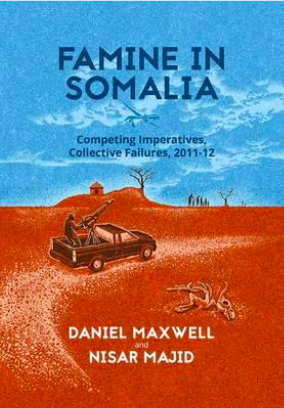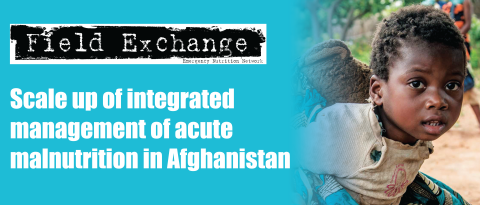Famine in Somalia: Competing Imperatives, Collective Failures, 2011-12
Book review1
By Solange Fontana
Solange Fontana is a DPhil candidate in International Development at the University of Oxford. Prior to returning to academia, she worked as a humanitarian field practitioner, where she was interested in the intersection of livelihoods and protection. During the 2011-12 famine in Somalia and crisis in the Horn, she was regional emergency food security advisor for a large international charity.
 Famine in Somalia: Competing Imperatives, Collective Failures 2011-12 is an incisive, well-researched book whose implications reach far beyond famine and Somalia. A 21st-century Famine Crimes (de Waal, 1997), Maxwell and Majid take their readers into the murky world that creates famine. They expose the politics and examine the complex mixture of decisions and events that tipped crisis into a famine, costing the lives of an estimated 260,000 men, women and children. Famine in Somalia reminds us that famine is neither inevitable, nor solely the result of environmental degradation and drought. It is the outcome of processes, precipitated by human agency; whether due to the decisions and actions taken by Al Shabaab and the Transitional Federal Government (TGF) or inaction – as in the case of the international community. In our globalised, hyper-connected world there may be “no excuse for famine” (p.15), but it remains horrifically common. If it was Somalia yesterday, it is distressing images from Yemen and Syria that dominate the news today. Tragically, as the Deyr rains fail and donors prevaricate, it is depressingly likely to be Somalia again tomorrow. Even in our comfortable, western economies malnutrition and deprivation stalk those who have little voice. Famine is alive and well; in this pressing book, Maxwell and Majid explain why.
Famine in Somalia: Competing Imperatives, Collective Failures 2011-12 is an incisive, well-researched book whose implications reach far beyond famine and Somalia. A 21st-century Famine Crimes (de Waal, 1997), Maxwell and Majid take their readers into the murky world that creates famine. They expose the politics and examine the complex mixture of decisions and events that tipped crisis into a famine, costing the lives of an estimated 260,000 men, women and children. Famine in Somalia reminds us that famine is neither inevitable, nor solely the result of environmental degradation and drought. It is the outcome of processes, precipitated by human agency; whether due to the decisions and actions taken by Al Shabaab and the Transitional Federal Government (TGF) or inaction – as in the case of the international community. In our globalised, hyper-connected world there may be “no excuse for famine” (p.15), but it remains horrifically common. If it was Somalia yesterday, it is distressing images from Yemen and Syria that dominate the news today. Tragically, as the Deyr rains fail and donors prevaricate, it is depressingly likely to be Somalia again tomorrow. Even in our comfortable, western economies malnutrition and deprivation stalk those who have little voice. Famine is alive and well; in this pressing book, Maxwell and Majid explain why.
As one of only 58 known cases of famine since 1870 (de Waal, 2018), the Somali famine of 2011-12 stands out as an important case study thanks to the plethora of information and early-warning data available. 2 Despite ample warnings, field agencies and donors failed to agree on what this information was telling them and how they should react. The hesitancy of donors and agencies, aggravated by internal competition and concerns over delivering humanitarian assistance in a context like Somalia, and directives linked to the ‘War on Terror’, led to a “dangerous delay” in response (Oxfam and Save the Children, 2012) with tragic consequences. Yet the international and humanitarian community was not acting in a vacuum, as Maxwell and Majid’s perceptive analysis of “competing imperatives” makes clear. As relevant as Famine in Somalia is to both famine and Somali studies, the book’s implications extend far beyond its subject and geographic area. It should be obligatory reading for anyone working in crisis or in crisis-prone areas, whether academic, diplomat, policy-maker or practitioner. Moreover, its accessible style and the authors’ unusual inclusion of Somali narratives speaks to an even broader audience.
For a practitioner, and one involved in the 2011-12 response, Famine in Somalia makes uncomfortable reading, but Maxwell and Majid are unusual aid academics, and their extensive practitioner experience pervades the book. Their nuanced, compassionate critique sidesteps the issue that affects similar academic analyses – valid criticism, but few actionable (or feasible) suggestions for change. If in the last chapter (chapter 10: Preventing Famine: An Unfinished Agenda) the authors offer high-level suggestions for a “way out” (p.192), in chapters 5 and 6 they sensitively use Somali narratives to illustrate how elements missed by current assessment practices – the impact of historic exclusions, people’s networks of support and rural/urban linkages – skew our understanding of ‘vulnerability’ and ‘resilience’ in such contexts. Like so much in the book, the elements that emerge from the experiences of ordinary Somali householders are not exclusive to Somalia or famine. Rather, they reflect common elements of daily life in crisis, from experiences of living with conflict in eastern Congo, to refugee and migration narratives. Capturing these elements and mapping the institutions and mechanisms that order people’s daily lives would not only give practitioners a better understanding of what constitutes ‘vulnerability’ and ‘resilience’ in crisis, but could also identify alternate ways to channels assistance – particularly pertinent in areas which require remote working.
More than a simple milestone in famine literature and Somali studies, Famine in Somalia makes a strong empirical case for rethinking how we ‘look at’ crisis, from proposing an overarching framework for contextual analysis, to suggesting how we might re-evaluate local assessment practices. Furthermore, it challenges the humanitarian community to reconsider how we currently understand ‘vulnerability’ and ‘resilience’ in such circumstances.
It is a pressing book, with an important message. Yet, by focusing on Somalia, its title fails to reflect its scope. More appropriate would have been Competing Imperatives, Collective Failures, Famine in Somalia: 2011-12. Famine in Somalia may be a case study of famine, but the competing imperatives and complex mix of collective failures it describes are common features of crisis-escalation worldwide. It is competing imperatives and collective failures that are behind the current situation in Yemen and over 30 years of conflict in eastern Congo and which, tragically, despite books such as this, risk causing a repeat of yet another famine in Somalia in the not-so-distant future.
Endnotes
1From Analysis to Practice – Famine in Somalia: Competing Imperatives, Collective Failures, 2011-12 by Daniel Maxwell and Nisar Majid. London: C. Hurst & Company, 2016. v + 269 pp. Maps. Illustrations. £22.00 ISBN 978-1-84904575-9
2Note de Waal defines famine as a food security crisis with a death toll of over 100,000. This is different to the Integrated Food Security Phase Classification (IPC), whose thresholds are designed to capture the beginning to famine and where all three outcomes of mortality must be evident – in particular, CDR > 2/10,000/day; wasting GAM > 30%, and food consumption (near complete Food Consumption gap for >20% of the population) for an area to be classified famine-prone. See www.ipcinfo.org/ipcinfo-detail-forms/ipcinfo-resource-detail0/en/c/178965/
References
de Waal A. Famine Crimes: Politics and the disaster relief industry in Africa, London, James Currey Press, 1997.
de Waal A. Mass Starvation: The history and future of famine, Cambridge, Polity Press, 2018.
Oxfam and Save the Children. Dangerous Delay: The Cost of Late Response to Early Warnings in the 2011 Drought in the Horn of Africa, Joint Agency Briefing Paper, Oxfam and Save the Children, January 2012.


